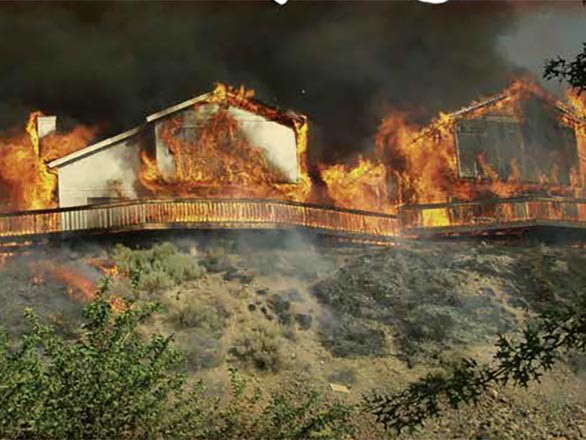Carson City at Risk
 There is more wildfire in our future and for many areas in Carson City, it is not a matter of “if” wildfire is going to occur, but “when”. Unfortunately, many residents and their homes are not prepared to survive wildfire. Faced with the growing potential for loss of human life and property due to wildfire, Nevada’s local, state and federal firefighting agencies, Nevada Fire Safe Council, University of Nevada Cooperative Extension and local county government have come together to promote the FAC concept. They believe this is the best response to decrease our wildfire threat. There are proven steps that homeowners can take to improve the odds of human life and home survival during wildfire. The purpose of the Carson City FAC project is to promote and teach these steps. Once implemented at the neighborhood level, these recommendations will assist communities in becoming FACs.
There is more wildfire in our future and for many areas in Carson City, it is not a matter of “if” wildfire is going to occur, but “when”. Unfortunately, many residents and their homes are not prepared to survive wildfire. Faced with the growing potential for loss of human life and property due to wildfire, Nevada’s local, state and federal firefighting agencies, Nevada Fire Safe Council, University of Nevada Cooperative Extension and local county government have come together to promote the FAC concept. They believe this is the best response to decrease our wildfire threat. There are proven steps that homeowners can take to improve the odds of human life and home survival during wildfire. The purpose of the Carson City FAC project is to promote and teach these steps. Once implemented at the neighborhood level, these recommendations will assist communities in becoming FACs.
Who Wins, Who Loses
Why do some houses survive a wildfire, while others are destroyed? Research findings prove that house survival during wildfire is not random, miraculous, or dumb luck. Rather, it is the features of the house, the characteristics of the adjacent vegetation and other fuels, and routine maintenance that often determine which homes burn and which survive. These types of actions are called pre-fire activities. Pre-fire activities are actions completed before a wildfire occurs that improve the survivability of people and the home. The winners will be the people who implement pre-fire activities. When everyone in the neighborhood completes their pre-fire activities, they start becoming a FAC.
Fire Adapted Community (FAC):
A community located in a fire-prone area that requires little assistance from firefighters during a wildfire. Residents of these communities accept responsibility for living in a high fire-hazard area. They possess the knowledge and skills to…
- Prepare their homes and property to survive wildfire.
- Evacuate early, safely and effectively.
- Survive, if trapped by wildfire.
The Elements of a Fire Adapted Community, Community Protection, Access, Defensible Space, Built Environment, and much more are found in the PDF version of the publication. Please use the link below to learn more.
Smith, E., Sistare, S., Nejedlo, G.
2011,
Fire Adapted Communities: The Next Step in Wildfire Preparedness, Carson City,
Extension | University of Nevada, Reno, SP-11-01


